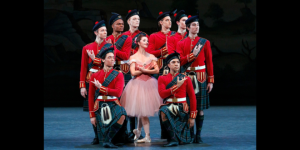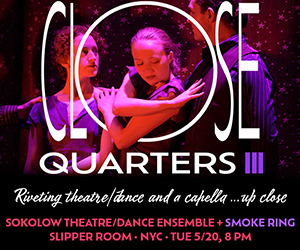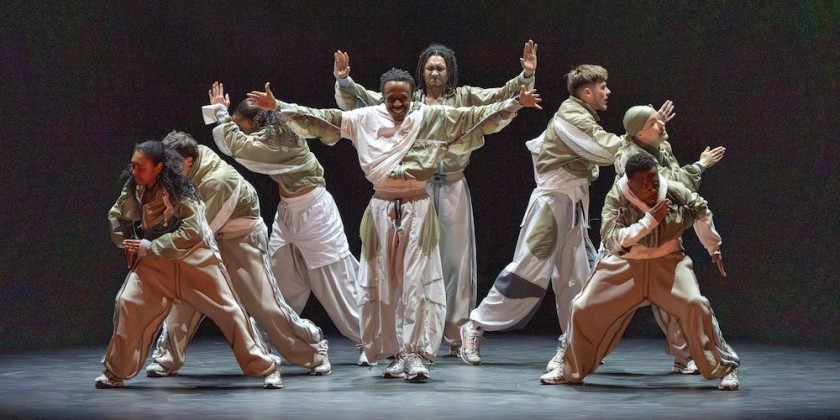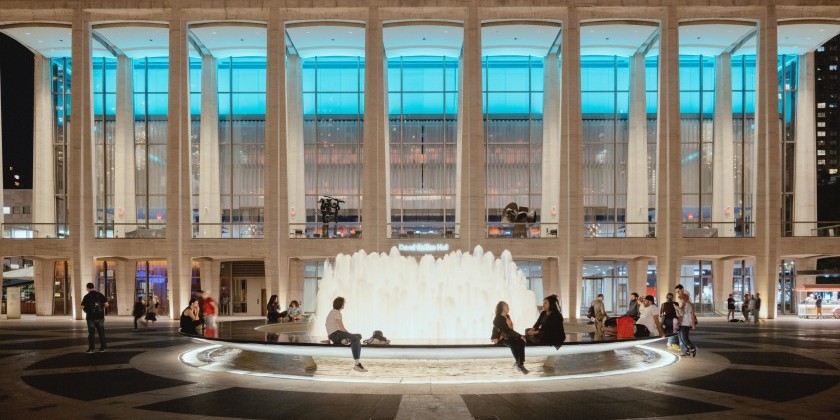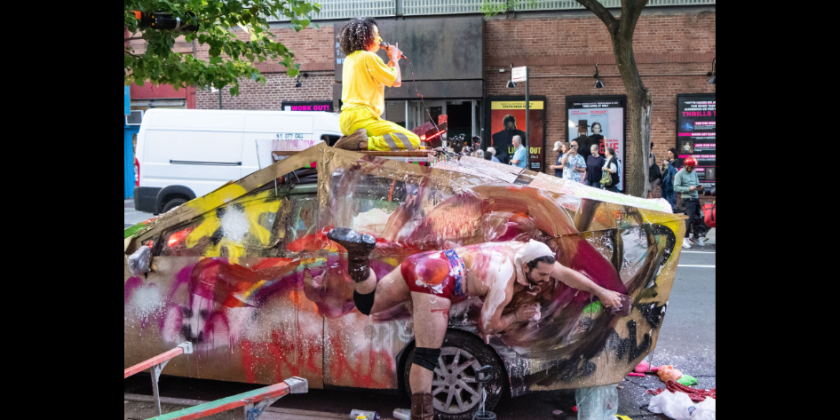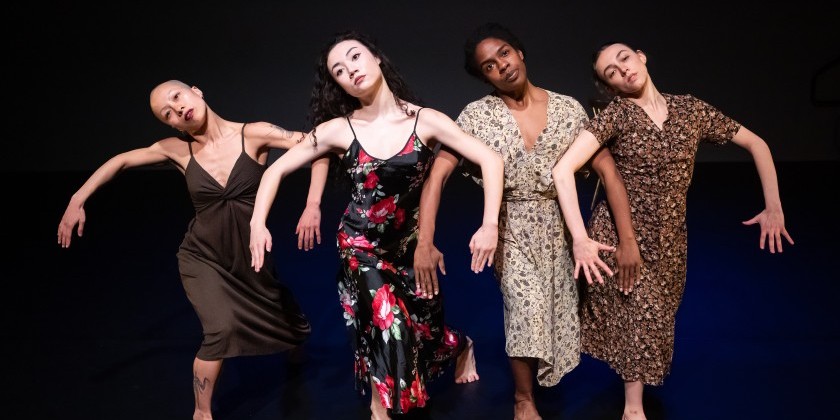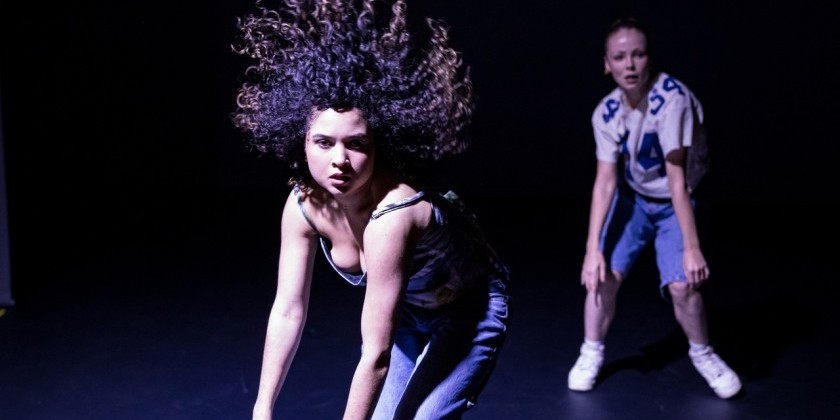IMPRESSIONS: Opening Night of New York City Ballet’s Spring Season
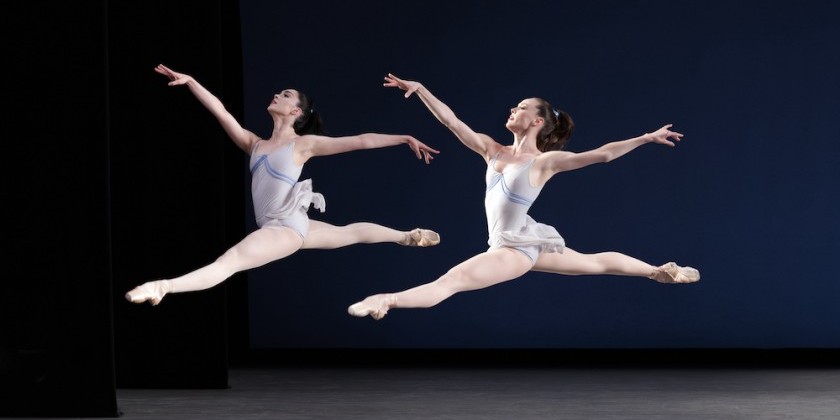
Featuring Balanchine, Robbins, Contemporary Ballet Choreographers, and Exciting Dancers
Tuesday, April 18, 2023 at 7:30pm
David H. Koch Theater Lincoln Center
The Company's full season runs through May 28, 2023
The opening night of New York City Ballet's spring season at the David H. Koch Theater served up an all-Balanchine program and emphasized the choreographer’s relationship to music. Johann Sebastian Bach's "Double Violin Concerto in D Minor" provides the playground for Concerto Barocco, which George Balanchine originally choreographed for American Ballet Caravan in 1941. He made sure to present it on the first night of NYCB’s inaugural 1948 season.
Two ballerinas personify the solo instruments. They illustrate and respond to the melodic lines in front of their orchestra of eight female dancers. Does Balanchine want to try to achieve the golden ratio with varying experiments relating to the diagonal? He places the corps in diagonal lines; the dancers face diagonally; and leg extensions and arms point to a diagonal. Balanchine makes it clear: when you have dancers face any corner and they extend a limb to the side you create another — are you with me? — diagonal.
At the end of the first movement, the two ballerinas exit along two diagonal lines of dancers heading for opposite corners upstage. Reaching the corner, however, one of them turns around accompanied by a male partner. They start their pas de deux traveling on a long diagonal. While Balanchine explores one spatial idea returning to it repeatedly, he does so with all the necessary tools to hold one’s interest. After dozens of viewings, I have not tired of this ballet and always focus on something seemingly new. (This time around, the “diagonal” presented itself as the ballet’s raison d’être.) Syncopation, call and response, unison movements (even if not uniformly executed by this opening night cast), and changing configurations keep the eyes transfixed in this masterful conversation with Bach’s heavenly music. The orchestra under the dynamic baton of music director Andrew Litton sounds glorious. Arturo Delmoni and Kurt Nikkanen are the two featured violinists.
Principal ballerina Unity Phelan brings exquisite poise to her part, and quietly draws attention whether opposite Ashley Laracey or expertly partnered by the self-effacing, yet gallant Tyler Angle, no matter how fancy the footwork happens to be.
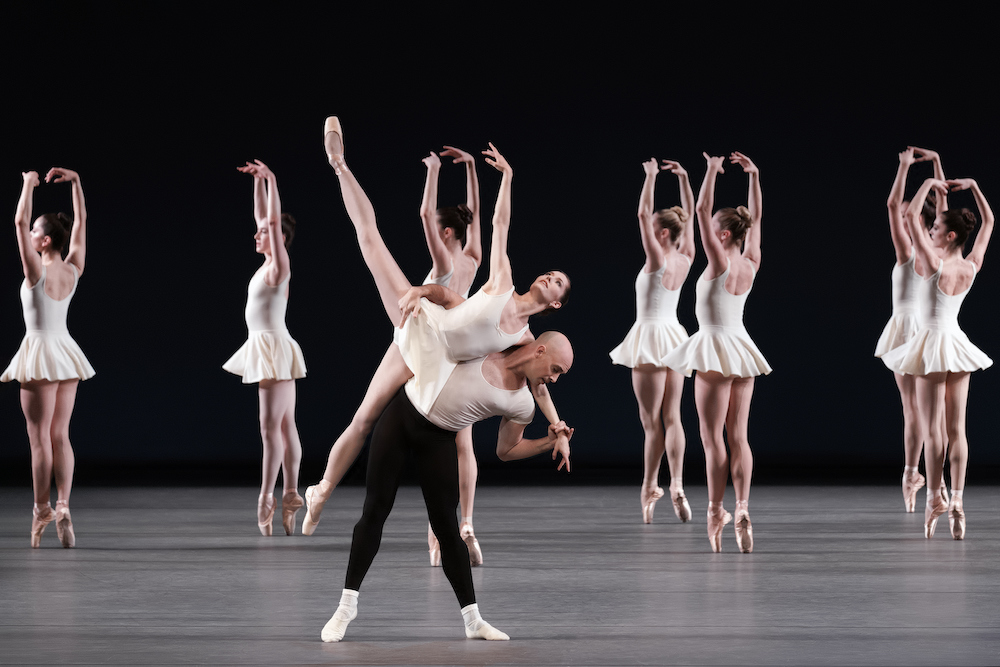
Unity Phelan, Tyler Angle, and company in George Balanchine’s Concerto Barocco; photo by Erin Baiano
Litton charmingly explains the intricacies of Paul Hindemith’s score for Kammermusik No. 2 in a segment named “See the Music…” Pianist Stephen Gosling and the orchestra play excerpts to illustrate some of the interesting discoveries Litton shares with his captivated audience. I do feel enlightened by the talk. During the ensuing presentation of the ballet, which I previously thought to be mechanical, I develop a new appreciation for its music. Knowing that one melodic line happens an eighth-note after the other also makes its choreographic visualization more understandable.
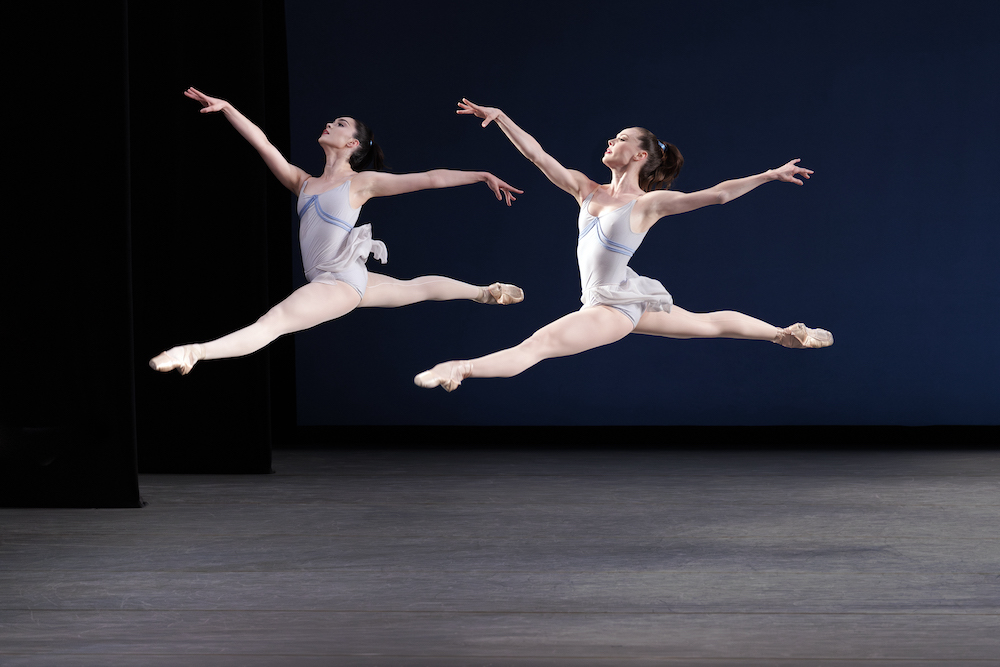
Mira Nadon and Emilie Gerrity in George Balanchine’s Kammermusik No. 2; photo by Erin Baiano
Programming Kammermusik No. 2 after Concerto Barocco supplies a study in visual counterpoint. In the choreographer’s response to Hindemith, eight men comprise the corps de ballet. Aaron Sanz brings a welcome lightness to this busy ballet, with a spring in his step. Harrison Coll stays earthbound, but executes his material perfectly. I am happy to see two differing individual approaches. They seem valid, even together. The ballet’s featured soloists Emilie Gerrity and Mira Nadon blaze through their difficult assignments. They work hard, and watching their efforts proves a satisfying exercise.
Raymonda Variations, performed to Alexander Glazounov’s score (NYCB continues its tradition of alternative transliterations of Russian composers’ names) closes the program. Just as in the two previous works, the lighting by Mark Stanley does not hide anybody or hint at anything, but simply illuminates the space and its inhabitants.
Twelve women in pink tutus and a principal male/female couple in turquoise (costumed by Karinska) look pretty in front of a backdrop depicting an overgrown park, which picks up these colors in its tree blossoms and moody sky (scenery by Horace Armistead).
Some of the women are featured with individual variations later in the work, but, even in the group, everyone gets to dance. A peculiar attack with which almost every dancer tries to emphasize height in the big jumps, I find jarring. The front leg pierces the air with a développé, and the force of the leg jutting out reverberates in the dancer’s torso transforming the step into a misplaced battle cry instead of an expression of joyful exuberance.
The twelve women often crisscross the stage in trios. Three tall dancers appear opposite three short ones (and three almost tall women face almost short ones). Eventually, they form an ascending line, which, of course, could be seen as descending if you start scanning it from the other side. Anyway, someone paid attention, but I question the effect. Does it have a whiff of dehumanization? To me this arrangement unnecessarily brings the air of an old-fashioned military drill to the proceedings. But then, I am not an admirer of the czarist hierarchy which produced the 1898 Petipa original, and which provides the foundation on which Balanchine built his aesthetic. While I think his work is most interesting when he starts to deconstruct the pyramidal structure and breaks up symmetry, throwback ballets such as Raymonda Variations entertain audiences and keep dancers on their toes.
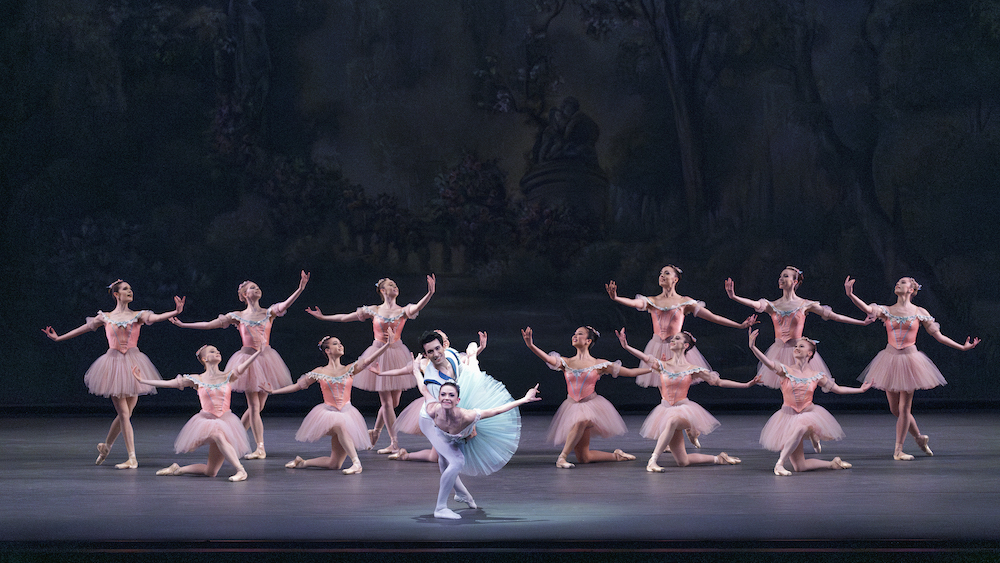
Perfection of classical style and technical prowess are not achieved by daily class alone. The fiendishly difficult variations, designed to challenge each dancer with a different task, let the eye take in various qualities.
Claire Von Enck hops on one pointe for so long that one questions if the solo was created for a one-legged dancer. I want to point out that Von Enck does master all her steps in the variation, no matter what foot she is on. Kristen Segin’s and Meaghan Dutton-O’Hara’s solos are broken up by the appearance of the principal dancers in their first, respective variations. Dutton-O’Hara combines a winning demeanor with sound technique. The arms are as important, if not more so, than the legs in Lauren Collett’s variation, and she conducts herself with gleefully authoritative exuberance. Emily Kikta spins and turns, and spins again exquisitely.
For the principal couple, Raymonda Variations tests stamina.
Megan Fairchild infuses her leg extensions with generous breath. Her musical phrasing delights, and she beautifully explores subtle shadings of movement qualities when repeating a sequence. Does she hold her torso sometimes a bit too upright for my personal taste? I have to remind myself that classical ballet might require a certain stiffness to hold a balance or showcase rapid footwork. Her pas de chats travel quickly and lightly across the stage and reverse direction with giddy surprise. Fairchild has learned how to tease with her timing, and her dancing transmits genuine joy.
In his solo parts, Anthony Huxley exudes the confidence that he unfortunately lacks when he partners. In his first variation, he soars and brilliantly beats his legs in every brisé. In each sissonne, he separates his legs widely and lands in a perfectly tight fifth position. He holds his balance after a pirouette, and takes risks that I have not seen him take in the past. It’s exciting to watch. But by the end of his last variation, he is out of breath. No matter, I am grateful he gives his all, even if it only lasts for 98% of the ballet. By trying he will build the needed stamina or learn how to pace himself.
The journey in search of perfection is often more thrilling to witness than perfection itself. I am grateful to the current artistic team and to these dancers for taking on the whole ballet, since I remember performances toward the end of the last millennium when the last couple of variations were cut because no one could get through them.
With a plethora of exciting dancers in its ranks and a rich catalog of ballets by the company’s founding choreographers, Balanchine and Jerome Robbins, as well as a number of new works by current choreographers, New York City Ballet’s spring season (running through May 28) is not to be missed.





